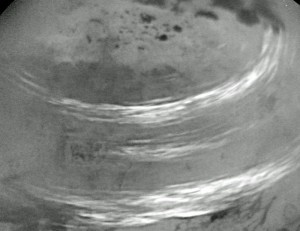NASA’s Cassini spacecraft is currently conducting a series of elaborate dives in which it repeatedly comes closer to Saturn than ever before. But during its slower periods, NASA is still using the craft’s fantastic photography equipment to grab images of Saturn’s nearby bodies, such as the moon Titan. The latest photo from the agency shows Titan in all its glory, complete with some very volatile cloud cover.
The new images, which were captured by Cassini on May 7th but not released immediately, show Titan in impressive detail, with long, feathery streaks of clouds obscuring portions of the landscape. But unlike the clouds we’re used to here on Earth — which are made of extremely tiny water droplets or bits of crystalized ice — the clouds you see in the Titan photos are actually made of methane.
In addition to Titan’s wealth of atmospheric methane, the planet also has vast lakes thought to be primarily made up of liquid ethane and methane, along with nitrogen. That’s an extremely hostile combination, at least in terms of Earth-like life. However, NASA isn’t ruling out the possibility that there may actually be methane-based life on the large moon, and even has some theories as to how it might survive.
According to NASA, these new photos were snapped at a distance of about 316,000 miles, which means that each pixel of the image equals roughly 2 miles. With that scale in mind, take a look at the dark splotches dotting the top of the image. Those are the huge methane-filled seas, which may or may not be home to huge, methane-filled whales.
Ask me anything
Explore related questions






